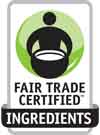What's behind Fair Trade USA's new labels?
Fair Trade USA's new labels represent more than an updated look. Find out what the bold seals say about the organization's revised policies and goals.

For the first time since 1998, Fair Trade USA (FTUSA) redesigned its Fair Trade Certified labels—and there’s more to their new look than what meets the eye, including FTUSA's revised ingredients policies. Here are three implications of the updated seals.
1. Increased transparency
FTUSA’s recent Multiple Ingredients Policy, which would only require 25 percent Fair Trade Certified ingredients to get the “Fair Trade Certified” label and 10 percent for the "Fair Trade Certified (Ingredients)" mark raised concerns from opponents such as Fair World Project who argued that these guidelines were too loose. The new labels, introduced last month, come with significant updates to this Multiple Ingredients Product Policy that are meant to “strengthen and clarify the requirements for the usage of both the full label and the ingredients label,” said Mary Jo Cook, Fair Trade USA chief impact officer.
 Now, any product (multiple ingredient or not) must contain 100 percent fair trade ingredients to earn the full label. For the ingredients mark, products must contain at least 20 percent Fair Trade Certified content; additionally, 100 percent of any ingredient that can be fair trade must be.
Now, any product (multiple ingredient or not) must contain 100 percent fair trade ingredients to earn the full label. For the ingredients mark, products must contain at least 20 percent Fair Trade Certified content; additionally, 100 percent of any ingredient that can be fair trade must be.
“The ingredients label was redesigned so that customers can clearly differentiate full Fair Trade products from those containing a mixture of Fair Trade and non-Fair Trade ingredients,” said Cook.
2. International reach
With the new label, the fair trade certification can be registered globally, widening the reach of Fair Trade Certified products, according to Cook. “Our goal is to create more demand for Fair Trade Certified products, which means more impact back to farmers,” she said. For this reason, FTUSA not only started working with mixed-ingredient product producers, but also wanted to expand into the global market.
“Companies who want to work with Fair Trade USA in more than one country can do so seamlessly because the more regions in which they sell their products, the more impact back to farmers.” Cook points out that companies only doing business in the United States can keep their current label for as long as they want.
3. Stronger identity
The redesign, which has been in the works since early last year, is meant to enhance the "shelf pop" at retail. The shift from simple black and white to a more dynamic bright green also intends to raise awareness around fair trade’s inherent environmental qualities. Another simple goal: to better communicate the words “Fair Trade Certified,” the key phrase that customers look for, said Cook.
What do you think about the labels' new look and updated policy? Leave a comment.
About the Author
You May Also Like





